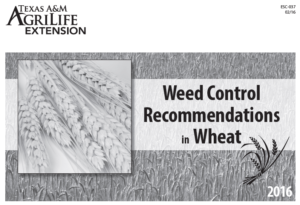Dr. Calvin Trostle, Extension Agronomy, TAMU Soil & Crop Sciences, Lubbock, TX
(806) 723-8432, ctrostle@ag.tamu.edu
Wheat farmers in the Rolling Plains, Concho Valley, and especially the High Plains, may have enough time to implement some late-season weed control in problem fields. For some farmers, earlier weed control with 2,4-D products may have given incomplete control for mustards, London rocket, kochia, etc. As many farmers across Texas know there is always some risk using growth-regulator type herbicides in wheat due to injury potential on grain yield. These herbicides include 2,4-D, dicamba, and MCPA.
Several Texas A&M AgriLife weed scientists over the years have routinely expressed reservations about applying any of these products once jointing starts. This is despite the labels offering that option. If a farmer uses 2,4-D or dicamba in these situations, it is best to use a reduced rate. Amine may be a preferred option rather than ester to reduce injury potential. Reduced rates are a good fit because it is best to target weeds when they are small and more readily controlled.
In 2016 former Texas A&M AgriLife Dr. Clark Neely compiled “Weed Control Recommendations in Wheat,” ESC-037. See http://varietytesting.tamu.edu/files/wheat/docs/2016/Weed%20Control%20in%20Wheat%20-%202016.pdf The guide is less about actual recommendations, rather it lists a grower’s options along with key management pointers including:
• Application rate or range
• General weeds controlled
• Maximum weed size for optimum control
• Growth stage comments
• Tank-mix options
• Other small grains the herbicide is labeled for.
It is a huge task to summarize this kind of information.
Always confirm key information with the label.
For late-season weed control the growth stage may limit options. Farmers must decide about whether further herbicide expense is worth the cost. Also, for some herbicides the rotation restrictions become an issue, most likely if the wheat is in a cotton rotation or if you hope to double crop.
Table 1 lists the most likely herbicides Texas producers may consider for weed control options after jointing and as late as boot stage. All of these have control of mustards, and a few are also active on kochia. Several have tank-mix options. Bromoxynil (Buctril) by itself is not that effective on many weeds, but it is a good tank-mix option. A few of the herbicides in Table 1 already include bromoxynil. All the rest are labeled for use with Buctril for added control as a tank mix.
This is a guide for Texas producers to consider a few late-season weed control options. As of April 7, little wheat in the Lubbock region is at flag leaf yet, though it should occur shortly. But there is a wider window the further north for possible weed control in problem fields.
Again, be sure to confirm Table 1 information with the current label for each product.
